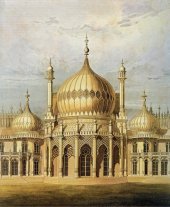 Neuerscheinungen 2015Stand: 2020-02-01 |
Schnellsuche
ISBN/Stichwort/Autor
|
Herderstraße 10
10625 Berlin
Tel.: 030 315 714 16
Fax 030 315 714 14
info@buchspektrum.de |

Stefan Koppelkamm
The Imaginary Orient
Exotic Buildings of the 18th and 19th Centuries in Europe
1st ed. 2015. 1952 p. w. 280 ill. 305 cm
Verlag/Jahr: EDITION AXEL MENGES 2015
ISBN: 3-936681-77-5 (3936681775)
Neue ISBN: 978-3-936681-77-2 (9783936681772)
Preis und Lieferzeit: Bitte klicken
In the 18th century the idea of the landscape garden, which had originated in England, spread all over Europe. The geometry of the Baroque park was abandoned in favour of a "natural" design. At the same time the garden became the "land of illusion": Chinese pagodas, Egyptian tombs, and Turkish mosques, along with Gothic stables and Greek and Roman temples, formed a miniature world in which distance mingled with the past. The keen interest in a fairy-tale China, which was manifested not only in the gardens but also in the chinoiseries of the Rococo, abated in the 19th century. The increasing expansion of the European colonial powers was reflected in new exotic fashions. While in England it was primarily the conquest of the Indian subcontinent that captured the imagination, for France the occupation of Algiers triggered an Orient-inspired fashion that spread from Paris to encompass the entire Continent, and found its expression in paintings, novels, operas, and buildings. This "Orient", which could not be clearly defined geographically, was characterized by Islamic culture: It extendedaround the Mediterranean Sea from Constantinople to Granada. There, it was the Alhambra that fascinated writers and architects. The Islamic styles seemed especially appropriatefor "buildings of a secular and cheerful character ". In contrast to ancient Egyptian building forms, which, being severe and monumental, were preferably used for cemetery buildings, prisons or libraries, they promised earthly sensuous pleasures. The promise of happiness associated with an Orient staged by architectural means was intended to guarantee the commercial success of coffeehouses and music halls, amusement parks, and steam baths. But even extravagant summer residences and middle-class villas were often built in faux-Oriental styles: In Brighton, the Prince Regent George (George IV after 1820) built himself an Indian palace; in Bad Cannstatt near Stuttgart, a "moorish" refuge was erected for Württembergs King Wilhelm I; and the French town of Tourcoing was the site of the Palais du Congo, a bombastic villa in the Indian Moghul style that belonged to a wealthy perfume and soap manufacturer.
Since the publication of his book Gewächshäuser und Wintergärten im 19. Jahrhundert (Stuttgart, 1981), Koppelkamm has repeatedly engaged with historic and actual aspects of architecture, cities and landscapes. Just as his last book, Ortszeit Local Time (Edition Axel Menges, 2005) could be seen as a search for a collective memory stored within architecture, Screening is a treatise on spaces and buildings that have no connection with their architectonic or social context. After studying film at the Otto-Falckenberg-Schule in Munich, Roland Schimmelpfennig went to work at the Münchner Kammerspiele, followed by the Schaubühne in Berlin, the Burgtheater in Vienna and the Deutsches Theater in Berlin.


